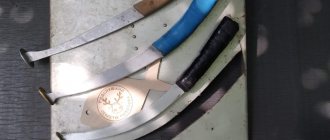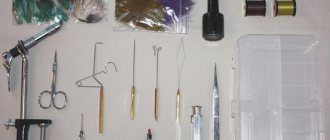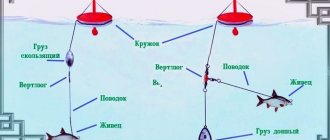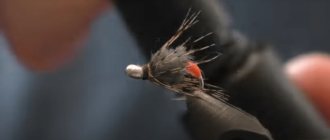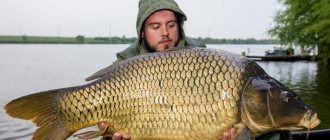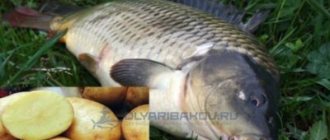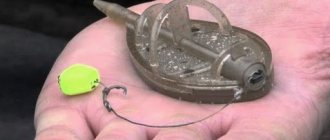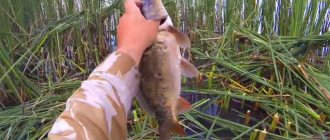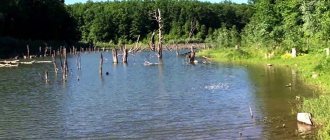Fishing with a spring has been actively practiced by anglers for a very long time, and this is not without reason, since this bottom method is very catchy.
A characteristic feature of fishing with a spring is that the groundbait (porridge) and bait on the hooks are fed to the fish at the same time (and sometimes the groundbait is also bait).
The principle of the spring: the fish begins to suck in pieces of thick bait, and soon swallows the hook with the nozzle, which is located right next to the spring with the porridge. Self-hooking of fish often occurs.
Porridge for the spring
As a rule, a variety of cereals are used as bait. Some of the most common porridges are corn and millet porridge, to which ground macadamia or ground seeds are added. The option with ground seeds is preferable.
Whatever ingredients are used, the porridge should be sufficiently viscous so that it holds well in the spring and does not disintegrate too quickly. Also, many fishermen add various smells to the porridge, for example vanilla, cinnamon and other flavorings, which are very good at attracting crucian carp.
A modern analogue of a spring is fishing with method feeders (flat). The principle of a flat feeder is the same as that of a spring; the main difference is in the design of the flat feeder itself. Read more about flat fishing by following the link.
Spring equipment
In cases where the spring itself is equipped with a sinker, the hooks are tied directly to it. During the fishing process, and due to the weight of the same spring, self-hooking often occurs.
Leashes and hooks:
- Number of leashes - from 2 to 6;
- the length of each of them is about 5 cm;
- leashes are tied along the edges of the spring;
- leashes are made from thick braid or nylon thread.
- Use small hooks.
In other cases, springs without a sinker are used, one large or several smaller ones. With this option, a main sinker is tied to the end of the fishing line, the weight of which is selected individually, taking into account the conditions in which you will be fishing.
The average weight of an individual sinker is approximately 30-50 g.
Behind the sinker there is 1 large or 2-3 small springs, near each of which one five-centimeter leash with a hook at the end is attached.
Article on the topic: how to make bait for crucian carp
Bream on a spring
I have seen various rigs and gear for bream, but this was the first time I discovered this cunning and, at first glance, useless design for fishing. And it all started when Vitka confused us:
- Guys, the bream is coming to Kokshag! - Is this on our stinking river? – Sergei muttered lazily. “There are only bottles floating in it and poop.” - Yes, not behind the dam, not behind the pipe. Right in the city, next to the beach, by the cable-stayed bridge. The water there is clean, they constantly take samples so that people don’t catch the infection.
We were just sitting and deciding where to go fishing. I would like to go further, to the Volga or Vetluga. And here - in the city...
But Vitka, meanwhile, took out a bag from his backpack in which there were silver breams, not breams, but white breams and quite large ones. There were five kilograms in the package. It turned out that the fish was eaten on ordinary bread crust, cut into cubes. We haven’t used this attachment yet, but Vitka was always coming up with something, experimenting and testing his innovations on our city river, which, however, was quite rich in fish, although well-fed, lazy and capricious, like the two-legged city dwellers - the inhabitants gray stone boxes.
The news, of course, excited us. Although it’s not very interesting to fish in the city, it’s a good idea to look for something when the bream is biting nearby. And we will also go to the Volga to, as usual, celebrate our arrival, and then on a full moon we will drive the werewolves around the islands. And the Volga fish is not going anywhere. She always bites there. And here, apparently, the local bream had a “bizk” in their big foreheads. Before the fish comes to its senses, we must hurry.
The fishing spot was the city beach, or rather its grassy outskirts, already without sand and sunburned swimmers. The squealing and splashing was far downstream. The conditions are tolerable, considering that fishing is in the city. The Malaya Kokshaga River flows almost in the center of Yoshkar-Ola and turns into a dug reservoir, which begins just behind the cable-stayed bridge, where we settled down to go fishing.
My gear was homemade donks made for a feeder from old spinning rods. I must say, the tackle is functional, especially for a small river where long casting is not required. The sensitive quivertip sentry, made of piano wire, nods more effectively. It immediately crackles like a feeder bell, which you have to cling to when you move away from the tackle. On the narrow riverbed of the Kokshagi below the city, where the banks are completely lined with trees, bushes, rose hips and nettles, there is no need at all for a long rod that is only used to catch branches. There I only use donks, leaving at home the branded feeder with a length of 3.9 m and a dough of 60-90-120 g.
But to the right of us sat an elderly fisherman with the usual hooks and bells on his fishing line. Nostalgia... Throughout my childhood, my father and I used this gear to catch spring roach, bream, and burbot at night. But the most unusual thing was that for ten of our bream weighing 300-500 grams, the fisherman caught one bream, but what kind... One, it seems, weighed two kilos. At least by eye.
Finally, we couldn’t stand it any longer, we approached, said hello and cautiously inquired about what the successful angler was fishing for. And he unexpectedly willingly showed and told everything. It turns out that at the end of the main fishing line there was a spring into which the porridge and, at the same time, leashes with hooks were pressed. The bream pulled out the porridge and hooks with tube lips. That's how I got it. It is somewhat similar to the modern flat method, only from the last century.
That's how this simple secret was revealed.
Alexander Tokarev
How my son suggested the nozzle
Fishing with a jig in the middle of nowhere
Pike and perch using live bait
Catching carp with a spring
To get a really good catch, it is, of course, advisable to use several bottom fishing rods at the same time.
As for the time of day for catching carp with a spring, night fishing will probably bring the best results.
It is worth adding sweet flavors (strawberry, caramel, honey, vanilla) to the bait porridge.
When fishing, do not rush to hook. As a rule, a carp bite is a series of light pokes, after which a sharp and strong jerk occurs. This is the moment you need to wait for and then quickly strike.
While fishing, try to maintain approximately a right angle between the rod and the tensioned fishing line to protect yourself from breaking the fishing rod or clutch. Having a high-quality spinning reel and a reliable clutch is a prerequisite when fishing for carp with a spring.
Catching crucian carp with a spring
There are no fundamental differences between a carp spring and a spring for crucian carp as such, but most often gear for crucian carp is characterized by smaller sizes, and therefore greater compactness.
The optimal size of the spring itself for crucian carp: height – 5 cm, diameter – 1.5-2 cm.
When a spring with hooks is attached between the weight and the main line, after casting, only the sinker will sink into the silt, while the spring with bait and hooks will be on the surface of the bottom soil.
This equipment is often praised by fishermen for its high sensitivity and good flight performance.
Crucian carp is well caught using millet porridge, corn porridge, or porridge made from peas and semolina. Additionally, crushed seeds, cake, various flavorings and animal food (chopped worms, maggots, bloodworms) are added to the porridge.
Structure of gear and DIY production
In the image you can see the classic equipment with a spring and one additional element. The spring load is in close proximity, at a distance of 5cm from it. This is done for the following reasons: more food is placed in the feeder, and it does not fall into the muddy bottom, which makes it more noticeable to the fish.
You should pay attention to feeders that have a wider distance between the turns, which will make it easier for the fish to get to the food.
Gear installation process
- You can make a spring yourself, but you can also buy it in a store, since it is not expensive. Several leashes with hooks are tied to the feeder. For leashes, it is better to use braided fishing line, as it is more elastic than monofilament.
- It is better to choose hooks depending on the size of the fish’s mouth, then it will be easier to swallow them.
- A branch is made from the main line to attach the feeder. The leash for the feeder must support the weight of the feeder during casting.
- The feeder is attached using a swivel and clasp. The swivel is needed to prevent the line from twisting.
- A sinker is attached at a distance of 5 cm from the feeder. It is better to use an olive shape with a longitudinal hole. Rubber stoppers can be installed along the edges of the sinker.
- The spring equipment is ready for use. A loop is made at the edge of the rig, which will help attach it to the main fishing line using the “loop-to-loop” method.
Spring with foam
Fishing with polystyrene foam works well in conditions where the bottom of the reservoir is covered with a layer of silt.
When the classic method of fishing with a spring does not bring results, small foam balls are used, which are placed on the hook (the tip remains open) and subsequently lift it slightly from the bottom.
It is known that both crucian carp and crucian carp often carefully try potential food first, and only then swallow it or, on the contrary, spit it out and leave it alone.
It is during such a “test” of the foam ball that the fish can be hooked.
However, she may completely ignore the foam, preferring to eat the porridge lying nearby. But even in this case, an outcome is possible in which the hook with a foam ball will be accidentally swallowed along with an abundance of bait.
Some fishermen, to give the foam a more attractive appearance, cover it with dough. You can use the same technique.
In fishing stores you can find foam balls of various sizes, colors and even smells, this allows you to choose the right size for a specific hook.
Types of springs
Donkey springs are distinguished according to the following criteria:
- Form;
- Size;
- Presence/absence of a sinker.
Donut spring
- This is the name given to a fairly long compression spring that curls into a ring.
- The average diameter of the base of such a spring is 1-1.5 cm, while the diameter of the “donut” itself into which it can be compressed is most often around 4-5 cm.
- The leashes are not attached to the spring itself, but through a special leash. Look at the photo on the right. The shape of the spring makes it easy and convenient to fill it with porridge.
Harvester spring (cone)
- The harvester is another type of spring that is clearly recognizable by its cone-shaped shape.
- Leashes, as a rule, are attached to the top of this kind of cone.
- It’s also a fairly convenient and compact spring, which won’t be difficult to get.
Crucian carp killer:
- Three springs in series without lead.
- There is one hook on each spring.
- The length of the leashes is 5 cm.
- Braided leashes.
- Hooks 4-6 numbers.
- The distance between the leashes is 12 cm.
- At the end of the line there was a sinker weighing 20-50 grams.
Very often, fishermen hook lard or foam onto their hooks, which increases the buoyancy of the hook and makes it easier for the fish to suck it in along with the porridge.
Equipment for spring carp fishing
Let's list all the most important things without dwelling on anyone's opinions. There is, so to speak, a standard set of actions and devices that give the desired result:
- The equipment is installed on a 0.3 mm fishing line.
- If you use a long leash, then either we tie a ten-centimeter twist in front of the feeder, or we take the feeder itself with an anti-twist.
- If the leash is short, then we knit a loop on a meter long line, then put a 3mm bead on the line, and then a 5 cm PVC tube, or a silicone locking knot. Now we put a spring on the fishing line. At the other end we knit a carabiner. It allows you to quickly change equipment. On average, its (equipment) length is 30 cm.
Read: Autumn carp fishing. Features and Tricks
Do you want to put two hooks? No problem. We place the first one below the feeder, the second one a little higher, and everything is ready. But how effective is using two hooks? The signaling device can be anything. High-tech lovers buy electronic ones. And those who are used to fishing the old-fashioned way take the most ordinary bell. There is such a universal signaling device. It is called "chupa chups". But the more official name is “swinger”. It costs a penny, but is highly effective. A lot depends on the sensitivity of the alarm. And it doesn't matter how much it costs. What is more important is how correctly it is attached.
Spring fishing technique
Having filled the spring with porridge and put bait on the hooks, we cast to the desired place in the reservoir, and then, in fact, wait for the bite.
It is highly advisable to cast the tackle in approximately the same place to ensure feeding of a specific area and attract the attention of a large number of fish.
- To throw the spring in the same place, you need to clip the line on the spool; this will not allow you to throw the fishing spot.
- The more rods you have, the higher your chances of catching more fish.
- Experiment with attachments. Try different baits right away, and then see which one bites better, use the best bait on all gear.
- You can also feed the place by hand, if the distance allows. The bait in this case should be looser than that in the spring.
Do not rush to hook, wait for an active bite and a strong jerk.
Fishing technique
Consists of stages:
- Fishing place. Study the bottom of the reservoir of your choice. If you find changes in the bottom, adjust the length on the fishing rod. Fish in one area to attract more prey.
- Preparation of inventory. Make sure that the equipment is intact and that the spring is firmly attached. Stuff the pre-prepared groundbait into the spring and the bait onto the hooks. Do not create unnecessary noise when casting - attach the bait so that together with the spring they look like a ball. In this case, you will be able to avoid the bait falling into pieces.
- Casting and setting up a fishing rod. Cast to the chosen location. The distance from the shore can be up to 50 m. Place the fishing rod on the stand and reel in the fishing line. It is important that the angle between them is similar to a straight line. The angle between you and the fishing rod should be equal to half a right angle. To ensure subsequent casts are accurate, make marks with a marker. Turn on the bayrunner and set up the alarm. Hang a piece of paper or a wad of seaweed on the top of your rod - this can serve as a good bite signal. Or attach bells. When going fishing at night, use special “fireflies”.
- Bite. It is important that the spring does not move. The muddy bottom will ensure its anchorage, because it sinks into it. Be patient and wait for the carp to appear. If the fish does not show itself, loosen the line to lull its vigilance. Seeing that the carp has reached the bait, do not rush to hook it. Give time to drag the spring and eat the bait, clinging more tightly to the hooks.
- If you notice sharp jerks after timid movements, immediately start hooking. Keep an eye on the fishing line - seeing its tension or sagging, you can safely consider this a sign of a bite.
- Gently pull the carp that has bitten towards the shore. In case you catch a large fish, make sure that the tension of the fishing line does not change. The carp, sensing the weakness, will try to escape by twisting the line, and with the help of sharp fins it will be able to break it off. Don’t bring the fish into the thickets; try to get them tired on the open surface. When the resistance weakens, feel free to drag the fish ashore. Remember, this fish can reach large sizes, so you need to be prepared for possible obstacles that will appear as a result of pulling it to shore.
Spring fishing gear
- Rod. To successfully fish with a spring, you will need the simplest fishing rod with a length in the range of 2.1-3.5 m. This can be either a plug-in model or a telescopic one; The main thing is that the rod is long enough and strong enough. Its test starts at 40 g.
- Inertialess reel. Size 3000-4000, preferably with a bayrunner
- Fishing line. Usually they put 100 meters of fishing line with a diameter of 0.25-0.3 mm.
- Leashes are most often made from braid with a breaking load of more than 5 kg, and their length is 5-15 cm, depending on the conditions and features of the equipment.
- Hooks - numbered from 4 to 9.
- Springs can be very different.
- As a signaling device, you can use a bell or a modern electronic bite alarm.
Installation of a spring for carp fishing
Assembling gear for catching carp with a spring is not a difficult task. There are no strict requirements for the performance characteristics of rods, reels and lines. The fisherman will spend little money, and at the same time will receive catchy and simple equipment.
Rod selection
For the spring, select a rod with a length of 2.4–4.1 meters, with a test weight of up to 50 grams. The structure of the “stick” does not matter. Some anglers even fish with fiberglass telescopes and manage to catch commercial carp, bream and crucian carp.
You can use a picker or a light feeder, 2.7–3.3 meters tall. The action of such rods is medium and medium-fast, the upper limit of the test is 30–70 grams. These rods are preferred because of their sensitivity, eliminating the need for bells and other bite alarms. All contacts of the fish are fixed on a movable top, painted in a bright color.
Coil
The rod can be equipped with an open inertial reel or a budget meat grinder size 4000–5000. In the first case, a powerful model like Nevskaya or Nelma is suitable. In the second - power, with a reduction of about 3.8: 1, with a capacious spool and a reliable friction brake.
Line and hooks
For fishing with a carp spring, both monofilament fishing line and braided cord are suitable. Moreover, nylon is better because it has a number of advantages:
- stretchable, well absorbs jerks of fish;
- unnoticeable;
- public.
Monofilament thickness is 0.25–0.35 mm, tensile strength is 4–7 kg.
Carp hooks use classic, round-shaped hooks with a short shank and medium size. It is necessary to monitor their sharpness and replace them promptly. The leashes with which they are attached to the equipment are thinner than the main fishing line, their length is 5–20 cm.
Groundbait and lures
For spring fishing, use mixtures of viscous consistency. They can stay in the feeder for a long time, do not fall apart, do not swell, and retain their working properties for a long time:
- special fishing clay;
- dough;
- homemade porridge;
- purchased bait mixtures.
Recommended reading: How to catch rotan using a spinning rod
Depending on the time of year, water temperature, and the characteristics of the fishing location, various flavorings must be added to the bait. For example, fruity scents work well in summer, and anise, fennel, and animal flavors work well in cold water.
The carp sucks food from the spring, gradually reaching the hidden hooks.
Hooks are often left empty, hidden in the bait. Sometimes balls of the same mixture are placed on them, which are hammered into the spring. If the carp takes it weakly, then you can try using animal bait - bloodworms, maggots, insect larvae, small worms.
Fishing with a spring in the current
Fishing with a spring becomes more difficult in conditions where there is a clearly noticeable current.
Then the spring is carried away from the desired place to another, and sometimes it can even be dragged along the bottom for a long time until some obstacle is encountered along the way.
To prevent such problems from arising, weighted springs are used.
It is also worth making sure that the bait is even thicker than usual when fishing in calm water.
Advantages of a spring
This tackle has gained popularity due to its compelling advantages:
- High probability of a successful catch. This tackle is cleverly designed: the fish is attracted by the smell of the bait, and it begins to actively eat it. The bait begins to disintegrate and a cloud forms around it, in which the fish discovers a more tasty bait and swallows it.
- Suitable for almost all types of fishing rods. Can be used when fishing in lakes and rivers with fast currents.
- The tackle is inexpensive and can be made with your own hands from scrap materials.
- Easy to cast, any beginner can throw this tackle.
